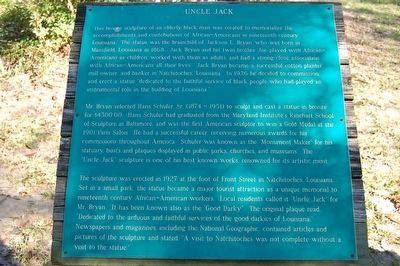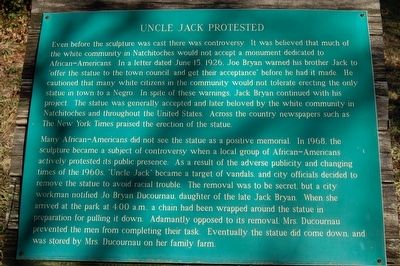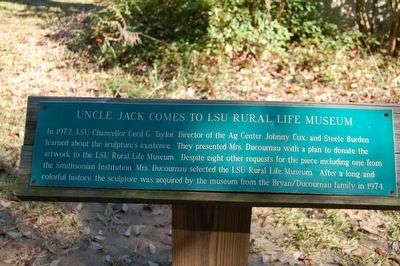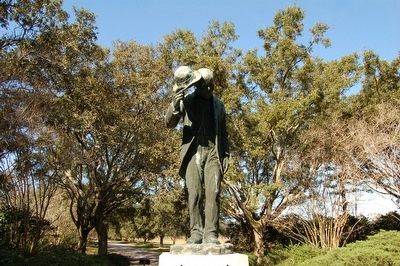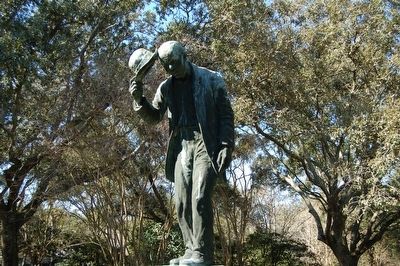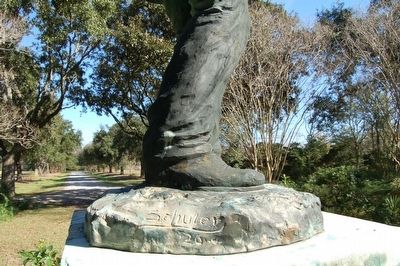Highlands/Perkins in Baton Rouge in East Baton Rouge Parish, Louisiana — The American South (West South Central)
Uncle Jack
Marker 1
Uncle Jack
This bronze statue of an elderly black man was created to memorialize the accomplishments and contributions of the African-Americans in nineteenth century Louisiana. The statue was the brainchild of Jackson L. Bryan, who was born in Mansfield, Louisiana in 1868. Jack and his twin brother Joe played with African-Americans as children, worked with them as adults and had a close strong association with African-Americans all their lives. Jack Bryan became a successful cotton planter, mill owner and banker in Natchitoches, Louisiana. In 1926, he decided to erect a statue "dedicated to the faithful service of black people who had played an instrumental role in the building of Louisiana."
Mr. Bryan selected Hans Schuler, Sr. (1874-1851) to sculpt and cast a statue in bronze for $4300.00. Hans Schuler had graduated from the Maryland Institute's Rinehart School of Sculpture in Baltimore, and was the first American Sculpture to win a Gold Medal at the 1901 Paris Salon. He had a successful career, receiving numerous awards for his commissions throughout America. Schuler was known as the "Monument Maker" for his statuary, busts and plaques displayed at public parks, churches and museums. The "Uncle Jack" sculpture is one of his best known works, renowned for its artistic merit.
The sculpture was erected in 1927 at the foot of Front Street in Natchitoches, Louisiana. Set in a small park, the statue became a major tourist attraction as a unique memorial to nineteenth century African-American workers. Local residents called it "Uncle Jack" for Mr. Bryan. It has been known also as the "Good Darky". The original plaque read, "Dedicated to the arduous and faithful services of the good darkies of Louisiana." Newspapers and magazines, including the National Geographic, contained articles and pictures of the sculpture and stated, "A visit to Natchitoches was not complete without a visit to the statue."
Marker 2
Uncle Jack Protested
Even before the statue was cast, there was controversy. It was believed that much of the white community of Natchitoches would not accept a monument dedicated to Blacks. In a letter dated, June 15, 1926, Mr. Jo Bryan warned his brother Jack, that before the statue was created he should “offer the statue to the town council, and get their acceptance.” Also he cautioned that to erect the only statue in town to a Negro would not be tolerated by many white citizens in the community. In spite of these warnings, Jack Bryan continued with his project. The statue was generally accepted and later beloved by the white community in Natchitoches and throughout the United States. Across the country newspapers such as The New York Times praised the erection of the statue by Jack Bryan. Interpretation of the statue began to change, and everyone developed his or her own opinion of the statue.
Many African-Americans did not see the statue as a positive memorial. In 1968, the statue became a subject of controversy when a group of Blacks actively protested its public presence. As a result of the adverse publicity and changing times of the 1960’s, “Uncle Jack” became a target of vandals, and eventually city officials decided to remove the statue to avoid racial troubles. The removal was to be secret, but city workmen notified Mrs. Jo Bryan Ducournau, daughter of the late Jack Bryan. Mrs. Ducournau was adamantly opposed to its removal. When she arrived, a chain had been wrapped around the statue in preparation for pulling it down. Mrs. Ducournau prevented the men from completing their task. Eventually the statue did come down, and was stored by Mrs. Ducournau on her family Farm.
Marker 3
Uncle Jack Comes to LSU Rural Life Museum
In 1972, LSU Chancellor Cecil G. Taylor, Director of the Ag Center Johnny Cox, and Steele Burden learned about the statue’s existence. They presented Mrs. Ducournau with a plan to donate the statue to the LSU Rural Life Museum. Despite eight other requests for the statue, including one from the Smithsonian Institute, Mrs. Ducournau selected the LSU Rural Life Museum. After a long and colorful history, the sculpture was acquired by the museum from the Bryan/Ducournau family in 1974.
Topics. This historical marker is listed in these topic lists: African Americans • Arts, Letters, Music. A significant historical date for this entry is June 15, 1926.
Location. 30° 24.665′ N, 91° 6.855′ W. Marker is in Baton Rouge, Louisiana, in East Baton Rouge Parish. It is in Highlands/Perkins. Marker can be reached from Essen Lane (State Highway 3064) south of Interstate 10, on the right when traveling south. Located on the grounds of the LSU Rural Life Museum. Touch for map. Marker is at or near this postal address: 4560 Essen Lane, Baton Rouge LA 70808, United States of America. Touch for directions.
Other nearby markers. At least 8 other markers are within walking distance of this marker. Cemetery (a few steps from this marker); College Grove Baptist Church (a few steps from this marker); Grist Mill (within shouting distance of this marker); Cane Grinder (within shouting distance of this marker); Split-Cypress Barn (within shouting distance of this marker); 18th Century Style Sugar House (within shouting distance of this marker); Pioneer Cabin (within shouting distance of this marker); Oak Ridge, Louisiana Jail (within shouting distance of this marker). Touch for a list and map of all markers in Baton Rouge.
Related marker. Click here for another marker that is related to this marker.
Credits. This page was last revised on February 12, 2023. It was originally submitted on September 6, 2015. This page has been viewed 769 times since then and 51 times this year. Photos: 1, 2, 3, 4, 5, 6. submitted on September 6, 2015. • Bernard Fisher was the editor who published this page.
